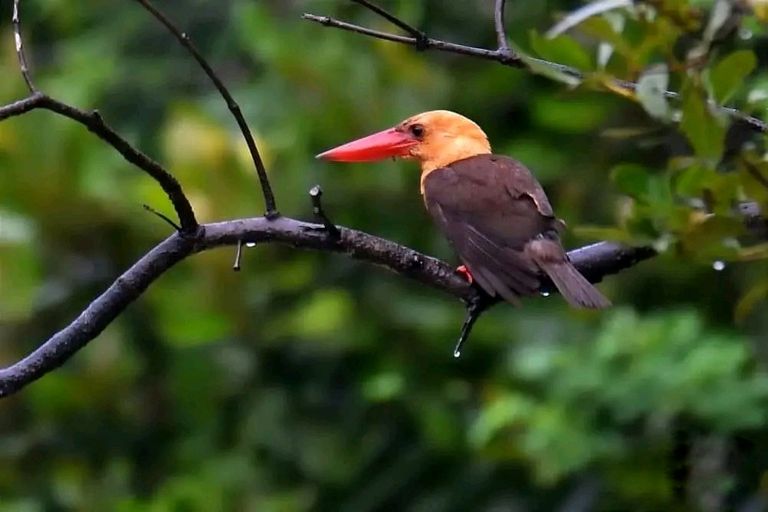Hello #BLURT Family. How are you all?
The Kingfisher is a group of short-tailed, large-headed and long, heavy, pointed beaks of the genus Alcedinidae, Halcyonidae and Cerylidae of the genus Coraciiformes. There are about 94 species of fish in the world. This bird is abundant in Southeast Asia and New Guinea, and there are many species in tropical Africa. There are 12 species of fish in Bangladesh.
Fisherman's lips and feet are the hallmarks of their identification. The legs are very short and joint-toed, the third and fourth toes almost vertically connected and the second and third toes attached at the beginning; In some species the second finger is too short or completely missing. The lips of a fisherman are proportionately large, quite thick, usually long and straight with eyes or slightly curved forehead. Fishermen come in a variety of sizes and weights; It is more than 40 cm long and weighs about 400 grams to 10 cm long and weighs a little over 10 grams. The feathers are usually brightly colored, blue, green, purple and reddish or brown with metallic luster, often with light white or black spots. The wings are usually short and round, while the tail is very short to very long.

Fish live in various aquatic habitats and forests. A pair of birds is a normal unit, nesting in a single or somewhat loose type of colony, but there is also a cooperative breeding cycle with the help of nesting. The nest is a normal hollow of a tree, a hole dug by another bird on a slope or a mound of weeds, or a hollow of a tree. Both males and females loosen soil or rotten wood with their beaks, dig holes, and throw soil or wood powder out of the holes with their feet. At the end of the hole is a wide chamber where the birds lay their eggs directly above the floor. During digging of the house, the contaminated hole is filled with a strong stench of discarded excrement, spilled food pills and leftovers. Like the Eurasian fisherman species, the young of the small fish-eating fisherman depend on their parents for up to 6 weeks before leaving home. To the birds of prey, the taste of fish meat is bad. The fisherman sits on the branches of trees to catch small fish, frogs and large aquatic insects. To catch prey, it lowers its head towards the water, often enters the water, returns to the branch with the prey, throws the prey on the branch a few times, then throws it into the air and swallows it from the side of the head.
Common Kingfisher of Bangladesh (Common Kingfisher, Alcedo atthis): Blue-green at the top, chata-color at the bottom, white spots on the neck. Spread all over the country; Blyth’s Kingfisher (Alcedo hercules): Apparently similar to the common fisherman, but large enough in size. Extensive mixed-evergreen forests; Blue-eared Kingfisher (Alcedo meninting): Dark purple-blue on top. Ear lids are blue. Extensive forested wetlands in the south-east, central and south of the country; Brown – winged Kingfisher (Halcyon amauroptera): Huge red lips. Head, neck and abdomen are brownish-yellow, tail is dark brown, back and buttocks are bright pale blue. Extensive mangrove forests in the Sundarbans; Stork-billed Kingfisher, Halcyon capensis: Large, large and pressed blood-red lips. Extensive forest cover near streams and irrigation canals; Ruddy Kingfisher, Halcyon coromandra: Cinnamon colored. The white hindquarters are visible while flying. Lips and legs dark red. Extensive mangrove forests in the Sundarbans; Black – capped Kingfisher (Halcyon pileata): Spread over St. Martin's Island and the entire coastline; White-throated Kingfisher (Halcyon smyrnensis): Bright blue with dark chocolate-brown color on the head, neck and abdomen. The chin, throat, center of the chest are shiny white. An interesting white spot is seen in the flying state. They can also be identified by their long, heavy and eye-catching coral-red lips and red legs. Spread all over the country; Collared Kingfisher (Todiramphus chloris): Greenish blue on top. White collar mixed with white belly color. The lips are black. Spread over the entire coastal region, including St. Martin's Island; Lesser Pied Kingfisher, Ceryle rudis: Scattering of black and white spots and dots. A few unbroken black stripes on the neck of the male bird. The female bird has a broken stripe. Spread all over the country; Wild fisherman (Oriental Dwarf Kingfisher, Ceyx erithacus): Dark-blue or light purple on top. Orange-yellow below. Coral-red lips, 3 toes. Spread over the forests of the country; Pied Kingfisher (Megaceryle lugubris): Large, white-black crest with large horizontally spotted back. The male has a lofty black crest, the wings and tail are dark gray, the bottom is white. Flying rust or cinnamon under the wings and armpits of the female bird while flying.
